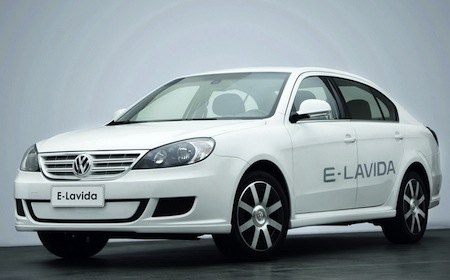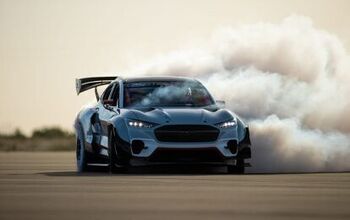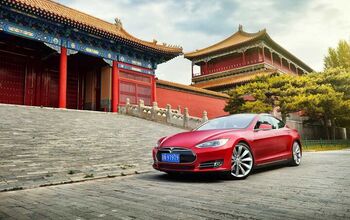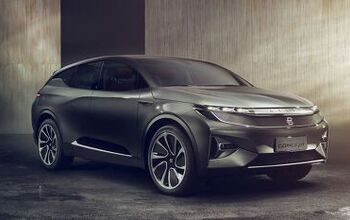Electric Cars Are Big In China… But Why?
Unlike long-wheelbase luxury, the other major theme emerging from coverage of the Beijing Auto Show was hardly unique to the Chinese market. Electric vehicles and talk of automotive electrification have become a highlight of every auto show, with politicians joining executives to push EVs whether the show is in Detroit, Paris or Beijing. And yet, with a power grid that is said to be upwards of 80 percent coal-powered, China isn’t exactly the ideal candidate for an electric car offensive. China’s BYD F3DM was arguably the world’s first plug-in “on the market,” and yet the Shenzhen-based automaker only found 48 fleet sales last year, and still has yet to report a private sale. Conventional wisdom suggests that most Chinese buy at the lowest end of the market (if they’re lucky enough to afford it), while the “coastal elites” tend to spend their hard-earned profits on vehicles that convey prestige rather than eco-optimism. This is a model the global carmakers know how to work with… so why all the talk of EVs in China?
That’s not a difficult question for BYD’s export directro, Henry Li. He tells The Detroit News that,
It’s not just a question of carbon dioxide but energy safety. That’s why we need electric vehicles.
In other words, if BYD wants to pass the likes of Toyota by liberating the masses with $8,000 F3s, it needs to worry about China’s ability to fuel them all. With Chinese annual vehicle sales expected to approach 20m units by 2020, coal-power’s downsides will be outweighed by its cheap price and abundant domestic reserves (having the world’s fourth-largest lithium reserves doesn’t hurt either). After all, China already imports over half of its gasoline. Still, even the most optimistic estimates see EVs remaining a relatively niche phenomenon for the foreseeable future. Zhenjiang Geely VP Frank Zhao reckons that by EVs will just be reaching ten percent of production by 2020, and that gas power won’t be surpassed until mid-century. And this despite a government program with the goal of putting a half-million plug-ins on the road by 2015.But the prospect of long-term growth has automakers scrambling, Chinese upstarts and global majors alike. BYD (which has signaled that it is backing off the plug-in game) and Daimler confirm to the WSJ [sub] that their jointly-developed, China-only EV will be market-ready by 2013. According to the DetN, Chery has signed a deal with Project Better Place to jointly develop EV technology for the Chinese market. GM has said that it will produce the Volt in China for the Chinese market, and The General’s Kevin Wale gushed in a recent presser that:The world premiere of the Volt MPV5 concept in Beijing demonstrates GM’s desire to make China a global focus of its advanced technology strategyGM’s Chinese partner SAIC isn’t sitting on its hands waiting though, developing a 2013 EV for Volkswagen based on its Chinese-market Golf-variant, the Lavida. And in return, Volkswagen’s Martin Winterkorn matched Wale’s sentiments, sayingSuccess in China has a significant meaning for Volkswagen in achieving its electric car strategy worldwideEven though BYD still has yet to find a single Chinese individual willing to buy the market’s first plug-in. What’s wrong with this picture? Most of the EV-boosting stories coming out of Beijing eventually mention a study by Ernst & Young [ PDF] which allegedly finds that 60 percent of Chinese people polled would “consider” buying a plug-in, with 82 percent saying a range of under 200 miles would be “acceptable.” E&Y’s Mike Hanley spins the results hard in favor of EV hype, claiming:Even if only a small portion of the 65% of survey respondents who said they would consider a plug-in or electric vehicle when introduced are serious, there would still be more than enough demand to sell out the 2010 and 2011 production runs of the major and new manufacturers, while buying time to build out infrastructure and increase public awareness.Which still doesn’t explain why the only plug-in on the market managed a mere 48 fleet sales in the last year. But then, hype does have a way of making reality seem less important.More by Edward Niedermeyer
Latest Car Reviews
Read moreLatest Product Reviews
Read moreRecent Comments
- Tassos Jong-iL North Korea is saving pokemon cards and amibos to buy GM in 10 years, we hope.
- Formula m Same as Ford, withholding billions in development because they want to rearrange the furniture.
- EV-Guy I would care more about the Detroit downtown core. Who else would possibly be able to occupy this space? GM bought this complex - correct? If they can't fill it, how do they find tenants that can? Is the plan to just tear it down and sell to developers?
- EBFlex Demand is so high for EVs they are having to lay people off. Layoffs are the ultimate sign of an rapidly expanding market.
- Thomas I thought about buying an EV, but the more I learned about them, the less I wanted one. Maybe I'll reconsider in 5 or 10 years if technology improves. I don't think EVs are good enough yet for my use case. Pricing and infrastructure needs to improve too.


































Comments
Join the conversation
Hate to point out the obvious, what happened when an EV plough into water? It doesn't happen everyday but just stay away from any Lakes, River or never launch any boats.
Combine 1 part right turns on red without having to stop, 2 parts not yielding to pedestrians, and 1 part pedestrians walking in the streets staring at cell phones with music blasting in their ears. Mix thoroughly with the bumper of a silent car, and your carnage cake will be ready in the amount of time it takes the ambulance to make its way through traffic that doesn't give one whiff about sirens and flashing lights. Enjoy!